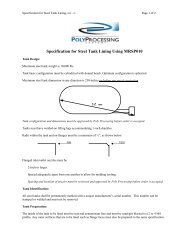Environmental Stress Crack Resistance - Poly Processing
Environmental Stress Crack Resistance - Poly Processing
Environmental Stress Crack Resistance - Poly Processing
You also want an ePaper? Increase the reach of your titles
YUMPU automatically turns print PDFs into web optimized ePapers that Google loves.
predominate degradation or chain scission occures. At this interphase region thestresses are the highest in the polymer structure. The crystalline region is a low energyarea because of the stability of the crystal structure. The amorphous region, while notas stable as the crystalline regions, is still relatively free of stress because themolecules in that region can move to relieve any stresses that might develop. Thus, atthe interface there is a pull effect between these two energy states. One can say thatthe molecules in the interphase region are “thermodynamically stressed” which makesthem more susceptible to environmental stress cracking. That is, it takes less chemicalenergy/interaction to rupture or chain session these tie molecules in the presence ofsurface active agents.We can also imagine that the molecules in the interphase region are mechanicallystressed. These molecules have their ends trapped in regions of quite different natures.Because of the ordered nature of the crystalline regions and low energy level, they tendto be stiffer than the amorphous regions. Thus, when heating or cooling occurs, thecrystalline and amorphous areas expand and contract at different rates and to differentextents. This will inevitably stress the molecules caught between these different forces.Moreover, because of the lower energy of the crystalline areas, the thermodynamicforces are always trying to enlarge the crystalline areas and thus are mechanicallypulling on the interphase molecules, which obviously create a stress. Because themolecular chains in the interphase region are in tension due to this pull effect, whenchain scission occures they spring back away from the interphase region and becomepart of the crystalline region. Therefore, we can now understand why there is anincrease in crystallinity with degradation.With the understanding that the interphase molecules are in stress and thatcrystallinity is increased with degradation, we can now accurately link the origin ofenvironmental stress crack resistance to the boundary region. The internal stressesraise the energy level of the interphase region. Therefore, when additional externalenergy is added to the molecule (as from a bending stress or the presence of asurfactant) the interphase is the place where the molecules are most likely toaccumulate sufficient energy to exceed molecular bond strengths and rupture.Therefore, chain scission from external stress and environmental effects is mostlikely to occur at the interphase.We now need to examine some of the effects of various important molecularparameters so that we can see how to increase ESCR by varying key characteristics ofthe resin.a- Effect of Molecular Weight:Molecular weight is simply a measure of the size of the molecules. In most cases,this size can also be related directly to the length of the molecular chains. With all otherfactors being the same, the longer the molecular chain of the polyethylene polymer, thehigher its ESCR.4
















